Products 929-944 of 1677
Show

Code: 1371-10-G4928 (8UK24)
In Stock
Availability: In Stock
Product of Greenland, Tanned in Poland
Item #: 1371-10-G4928 (8UK24) -
This is a Greenlandic sheepskin. Notes on the hide:This hide has a creamy coloring.The hair has a curly center with some curly or straight hair length. The straight hair length is 6" to 7".The under hair has some matting.The backing is flexible. Greenlandic sheepskins are not endangered. The skins we offer are a by-product of the food industry in Greenland. This animal was not killed just for the skin. No export paperwork is required for shipments outside of the United States. ...

Code: 1371-10-G2943 (Y2F)
In Stock
Availability: In Stock
Product of Greenland
Item #: 1371-10-G2943 (Y2F) -
This is a tanned Greenlandic sheepskin. Greenlandic sheepskins are not endangered. The skins we offer are a by-product of the food industry in Greenland. This animal was not killed just for the skin. No export paperwork is required for shipments outside of the United States.

Code: 1371-10-G2944 (Y2F)
In Stock
Availability: In Stock
Product of Greenland
Item #: 1371-10-G2944 (Y2F) -
This is a tanned Greenlandic sheepskin. Greenlandic sheepskins are not endangered. The skins we offer are a by-product of the food industry in Greenland. This animal was not killed just for the skin. No export paperwork is required for shipments outside of the United States.

Code: 1371-10-G2945 (Y2F)
In Stock
Availability: In Stock
Product of Greenland
Item #: 1371-10-G2945 (Y2F) -
This is a tanned Greenlandic sheepskin. Greenlandic sheepskins are not endangered. The skins we offer are a by-product of the food industry in Greenland. This animal was not killed just for the skin. No export paperwork is required for shipments outside of the United States.

Code: 1028-G01 (Y1E)
In Stock
Availability: In Stock
Product of South Africa
Item #: 1028-G01 (Y1E) -
These are tanned grey rhebok skins. Also known as grey rhebuck, it is a species of medium-sized antelope with the specific name capreolus in Latin meaning 'little goat'.The grey rhebok has a long neck, narrow ears, and straight, sharp horns that are ringed at the base. Only the males have horns. The coat is short and dense and are various shades of grey.Grey Rhebok are not an endangered species and not subject to CITES. A USFWS export permit is required for all shipments outside the USA. ...

Code: 1028-G02 (Y1E)
In Stock
Availability: In Stock
Product of South Africa
Item #: 1028-G02 (Y1E) -
These are tanned grey rhebok skins. Also known as grey rhebuck, it is a species of medium-sized antelope with the specific name capreolus in Latin meaning 'little goat'.The grey rhebok has a long neck, narrow ears, and straight, sharp horns that are ringed at the base. Only the males have horns. The coat is short and dense and are various shades of grey.Grey Rhebok are not an endangered species and not subject to CITES. A USFWS export permit is required for all shipments outside the USA. ...
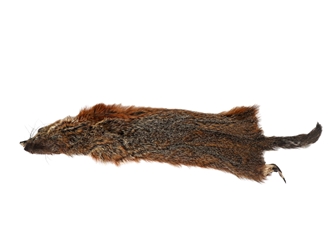
Code: 557-CR (Y2O)
In Stock
Availability: In Stock
Product of USA
Item #: 557-CR (Y2O) -
The craft grade groundhog or woodchuck skins may have holes, rips, tears, or be missing the head or tail. The groundhog skins are approximately 30" to 32" long by 4" to 6" wide with 6" to 8" long tails. These are also known as whistle pigs or land beavers. Woodchuck are not endangered and are not subject to CITES export controls. A USFWS export permit is required for all shipments outside of the U.S.
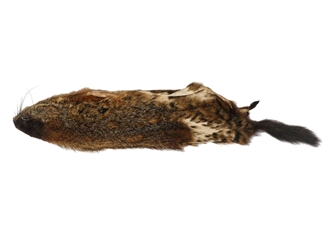
Code: 557-RJ (Y2O)
In Stock
Availability: In Stock
Product of USA
Item #: 557-RJ (Y2O) -
The reject grade groundhog or woodchuck skins are badly damaged and are suitable for fly tying. The groundhog skins are approximately 26" to 29" long by 4" to 5" wide with 5" to 8" long tails. These are also known as whistle pigs or land beavers. Woodchuck are not endangered and are not subject to CITES export controls. A USFWS export permit is required for all shipments outside of the U.S.
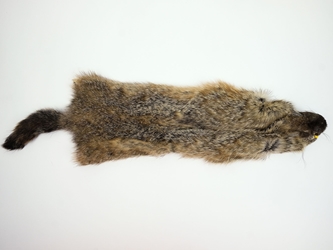
Code: 557-TP (Y2O)
In Stock
Availability: In Stock
Product of USA
Item #: 557-TP (Y2O) -
The trading-post grade groundhog or woodchuck skins are generally good quality skins with a head, good body, and tail. The groundhog skins are approximately 27" to 29" long by 5" to 6" wide with 5" to 7" long tails. These are also known as whistle pigs or land beavers. Woodchuck are not endangered and are not subject to CITES export controls. A USFWS export permit is required for all shipments outside of the U.S.
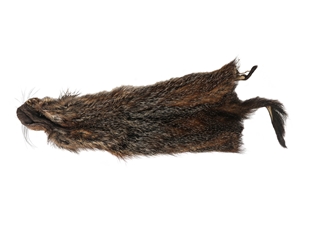
Code: 557-TPS (Y2O)
In Stock
Availability: In Stock
Product of USA
Item #: 557-TPS (Y2O) -
The trading-post grade groundhog or woodchuck skins are generally good quality skins with a head, good body, and tail. The small skins are approximately 11" to 12" long by 3" to 4" wide with 3" to 4" long tails. These are also known as whistle pigs or land beavers. Woodchuck are not endangered and are not subject to CITES export controls. A USFWS export permit is required for all shipments outside of the U.S.

Code: 1123-RZH056-1/8 (Y2L)
In Stock
Availability: In Stock
Product of Spain, Dyed in USA
Item #: 1123-RZH056-1/8 (Y2L) -
These are soft tanned rabbit strips that have been expertly cut to meet specific fly tying needs. They are half rabbit skins that have been pre-cut into zonker strips. They are available in a variety of cuts (strip sizes) and colors. These strips are standard cut, and are ideal for trout and most bass flies. The standard cut is 12” long by 5” wide and has 1/8” wide strips. Minimum order is 100 half skins. Please call for availability. ...

Code: 772-xxx
Variant
Availability: Variant
Product of Hungary
Item #: 772-xxx -
We carry limited quantities of Hungarian hamster skins. These skins are collected in the wild by gypsies in Hungary. They are used as lining in garments, for making flies by fly fishing hobbyists, making pillows, etc.The hamsters that we sell are not the same as the small golden hamsters that are sold as pets in North America. Interestingly, all of the golden hamsters living in captivity originate from a single female with 12 young which were dug from one burrow in Syria in 1930.The primary...

Code: 149-1-G6019 (Y2D)
In Stock
Availability: In Stock
Product of Canada
Item #: 149-1-G6019 (Y2D) -
This is one traditionally brain tanned, hair-on, hand-painted buffalo hide. This was prepared using real veal brains in a traditional manner by a non-Native origin European man living in Canada who is now accepted by the Lakota. This is the only hand-painted brain tanned hide we have like this. This is a great artistic piece. The hide has short hair and is a nice size, with shades of browns throughout. The mane has short hair and the backside is hand painted with horses...
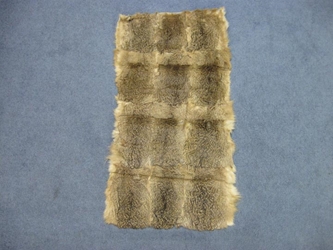
Code: 585-PL (Y3L)
In Stock
Availability: In Stock
Product of China
Item #: 585-PL (Y3L) -
These plates are made from the skins of real, wild rabbits or hares. Compared with the regular domesticated rabbits we offer from Spain, hare have thinner skins with fairly consistent coloring and long guard hairs. They are also referred to as Brown Hare.The hides used in making these plates are very thin and old, and may tear if you try to sew them, which makes them ideally suited for low-quality craft projects such as Halloween costumes. They are definitely not for fashion-quality garment...

Code: AGS02-G2175 (Y1J)
In Stock
Availability: In Stock
Product of South Africa
Item #: AGS02-G2175 (Y1J) -
The hartebeest is a grassland antelope living in central and southeastern Africa. Characterized by their long legs, large chest and sharply sloping back, these antelopes have curving horns and coats that range from dull sandy brown to tawny red to almost black, depending on the subspecies.The common name "hartebeest" is derived from the Afrikaans hertebeest. The name was given by the Boers, who thought it resembled deer. In Dutch, the word hert means "deer", and beest means "beast".Hartebeest...

Code: AGS02-G2257 (Y1J)
In Stock
Availability: In Stock
Product of South Africa
Item #: AGS02-G2257 (Y1J) -
The hartebeest is a grassland antelope living in central and southeastern Africa. Characterized by their long legs, large chest and sharply sloping back, these antelopes have curving horns and coats that range from dull sandy brown to tawny red to almost black, depending on the subspecies.The common name "hartebeest" is derived from the Afrikaans hertebeest. The name was given by the Boers, who thought it resembled deer. In Dutch, the word hert means "deer", and beest means "beast".Hartebeest...